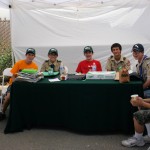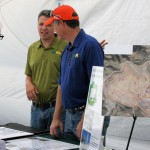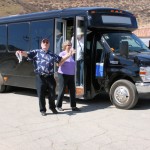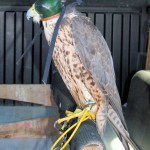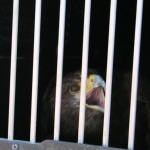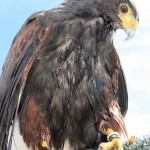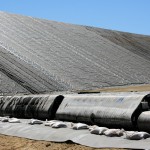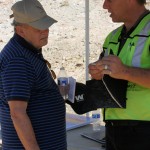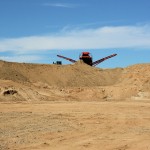About 50-plus people braved triple-digit temperatures Saturday to visit the El Sobrante Landfill Open House.
Three bus tours scheduled during the 10 a.m. to 1 p.m. event provided a narrated program of how the landfill operates, including a sneak peak at a new phase now under construction. (Learn more about the design and environmental safety factors HERE and HERE)
It also was explained how methane gas produced by the landfill is converted into power to run the operation, producing enough electricity to supply 6,000 home for one year. (Learn how gas is extracted from the landfill HERE)
Much emphasis was placed on saving the natural habitat surrounding the landfill, as well as taking steps today to assure the property will be returned to an environment as a protected habitat for endangered animals and plants when the landfill closes. (Learn what plants and animals are endangered HERE)
A big hit of the tour was visiting the falconer and his birds that keep seagulls away from the trash. (Read more about the falcons HERE)
Personal tours of the landfill can be arranged by contacting Miriam Cardenas, mcarden4@wm.com or 951-277-5112.
- Miriam Cardenas and Lily Quiroa, left, greet visitors to the El sobrante Landfill Open House on Oct. 4
- Boy Scouts from Temescal Valley Troop 899 “man” a booth.
- Don McGlaughlin grills hamburgers at the open house.
- Employees were on hand to answer questions about the landfill.
- Three bus tours of the landfill were held during the open house.
- The bus stopped a few times along the tour route, but one of the most popular stops was to visit the falcons where it was explained that the birds are used to control the gull population attracted by the trash.
- The facolner explained that he drives the birds to the landfill each day and to keep them calm during the ride, he covers their heads with hoods which he makes from green leather.
- Hawks are also used to deter the gulls. Here a squawky hawk voices his displeasure at being caged.
- The birds are trained to chase the gulls; not to attack them although once-in-awhile, the obvious occurs. The falconer said the gulls are smart and it’s to a point now that as soon as they see the falcons and hawks they leave the landfill for safer scrounging grounds.
- People on the tour were treated to a not-so-common sight — preparation of a new landfill phase which happens only every three to four years. Here, liner is being placed in the empty cell.
- General Manager David Harich explains the many-layered liner that is being placed at the bottom of the landfill’s new phase.
- A gigantic rock seperator is spotted on a crest, looking much like a huge bird spreading its wings. Rocks must be extracted from the soil used to cover the trash or, during compaction, air pockets could form.


